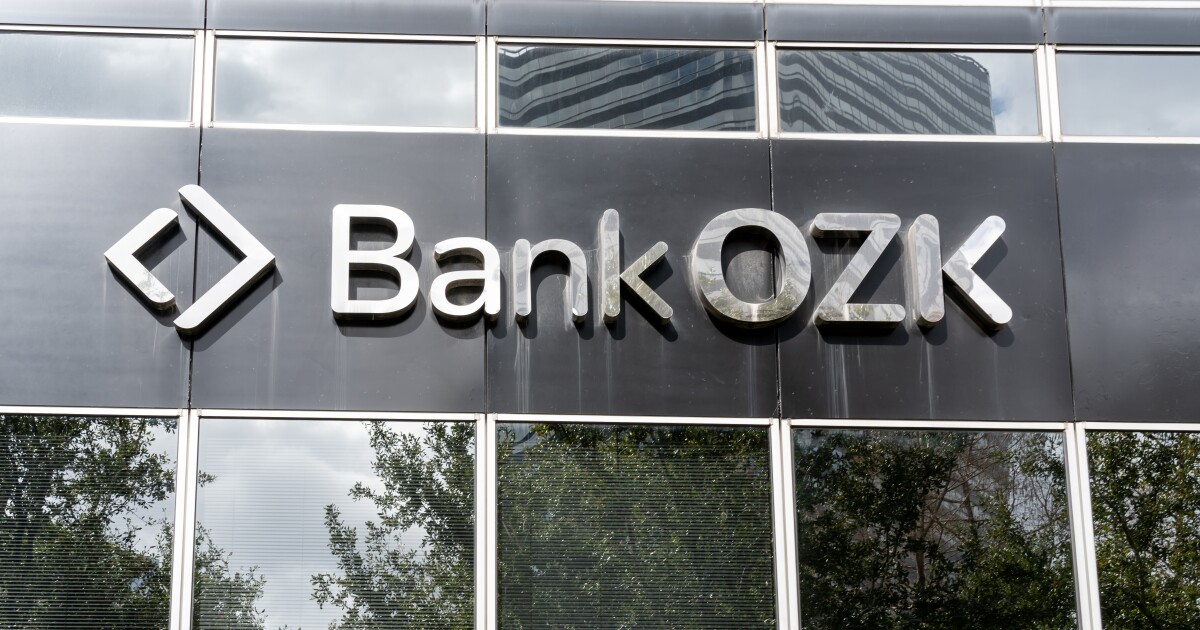
An Arkansas bank with one of the highest concentrations in commercial real estate loans in the country is planning to diversify its book, but not enthusiastically.
Bank OZK is one of the banks that has been facing heavy scrutiny as
After OZK released its quarterly earnings report this week, CEO George Gleason said the Little Rock, Arkansas-based bank will shift its growth emphasis away from real estate, which currently makes up about 75% of its loan portfolio, and toward its corporate and institutional business in an effort to assuage the market.
Still, the bank's earnings materials brimmed with confidence in its property portfolio. OZK has been playing defense since concerns about its commercial real estate loans took its stock price on a roller-coaster ride this spring.
"Commercial real estate is a complicated business, and it can be risky if you don't do it in an extremely disciplined manner," Gleason said. "We are extremely disciplined."
During OZK's earnings call on Thursday, both Gleason and Chief Financial Officer Tim Hicks both spoke about how the $37 billion-asset bank might diversify its business.
OZK would jump at a chance to revive a once-core strategy of buying failed banks, if any opportunities arise, Gleason said. In 2010 and 2011, OZK acquired seven failed institutions from the Federal Deposit Insurance Corp., growing its total assets by 36% in that time.
"If any FDIC transactions occur, we would love to have an opportunity on those," Gleason said. "And you probably noted the one sizable deal that's occurred this year, we were in the bidder group on that."
The April collapse of Republic First Bank in Philadelphia is the only bank failure so far in 2024. It led to the sale of the defunct company's $6 billion of assets and $4 billion of deposits to Fulton Financial in Lancaster, Pennsylvania.
"We'll continue to look very favorably on opportunities to acquire failed bank transactions if there are any, and that is always a preferred way," Gleason said.
Hicks said that OZK's 10.92% capital ratio positions the bank to branch out from CRE through paths such as acquiring a bank, growing loans organically or adding new business lines.
But Gleason indicated that OZK would be looking to diversify reluctantly — and not because of any weaknesses in the lender's CRE-heavy business model.
He said that he thinks the bank would be trading at a two- or three-multiple premium to peers based on its financial performance, if not for "folks that don't understand the unique expertise and capabilities and conservative approach we take to commercial real estate."
During the call, Gleason was peppered with questions from analysts about the state of OZK's CRE book, and he repeatedly expressed certainty about the strength of its credit quality.
In the second quarter, OZK saw net charge-offs increase to $11.8 million from $7.3 million the prior quarter. The bank also built its provision for credit losses by 14% from the previous quarter to $49 million.
Gleason said that OZK had been expecting high interest rates to cause an increase in net charge-offs this year, but that the bank's bad loans are still "well below industry average."
"That's not an indication of any sort of serious weakness in the portfolio," he said, adding that the bank added $274 million to its allowance for credit losses over the last eight quarters because it expected a certain amount of credit deterioration.
Though the bank's credit quality weakened during the second quarter, OZK also reported its highest level of loan repayments in two years, totaling $1.81 billion.
Erika Najarian, an analyst at UBS, wrote in a note that moving those repaid loans off the balance sheet was "encouraging."
In May, a report from Citigroup analyst Ben Gerlinger cast doubt on two of OZK's major CRE financing deals, and Gerlinger downgraded the bank from "buy" to "sell." OZK's stock price dove some 20% in the following weeks but has since made up most of the loss.
After OZK's second-quarter earnings report, which included information meant to illustrate the strength of the loans that drew Gerlinger's attention, the Citi analyst wrote that while credit was "nothing dire," he was maintaining his "sell" rating.
The first bank failure of 2024 will result in the Lancaster, Pennsylvania-based Fulton nearly doubling deposits in Philadelphia, a market it has viewed as strategically important for several years.
Banks with outsized exposure to the CRE sector have been feeling pressure for months, as work-from-home trends, inflation and rates that rose rapidly devalue many properties and stress some borrowers.
Because loans in the sector are notably opaque, and their riskiness varies based on factors like geography and borrower type, it's difficult for outsiders to assess loan performance.
But the market still reacts. Banks with higher CRE exposure had poorer stock performance in 2023, according to data from the Federal Reserve Bank of St. Louis.
In April, Valley National Bancorp
Some institutions with CRE loans exceeding 300% of their capital have been subject to heightened regulatory scrutiny. OZK's ratio was over 350% at the end of the first quarter, according to regulatory data.
The bank will likely fall under the 300% mark as it continues to add to its corporate and institutional banking team, and builds on its indirect RV and marine lending business, Gleason said.
"We're not specifically focused on getting below the [300% threshold]," Gleason said. "That will probably be a natural product, though, of diversification. It's not the goal. It's just a byproduct of diversifying our balance sheet so that we can get the multiple that our shareholders deserve for the high-quality performance we put up."
The bank's stock price saw minimal movement following its earnings report.



